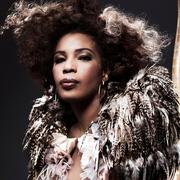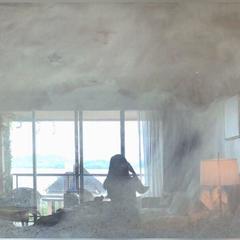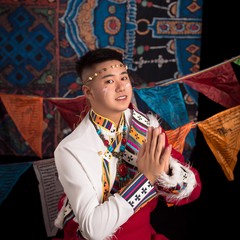Macy Gray
MACY GRAY原名纳塔莉-麦金太尔(Natalie Mcintyre),出生于美国俄亥俄州坎顿市。尽管人们把Gray奉为灵魂音乐的救星,但是她本人从不以此自居,而是常常向人们讲述他童年的故事。那时她因为嗓音特别经常引来其它孩子们的嘲笑,她也因此轻易不敢开口讲话。她的嗓音融合了 Billie Holiday和Tina Turner两种嗓音的特色,但又与蓝调音乐和说唱表演者的陈腐风格完全不同,能够给人一种耳目一新的感觉。她的首张唱片在1999年秋天一推出就吸引了批评家和音乐爱好者的注意。Gray 曾接受过几年的正规钢琴训练, 她的成长过程中被灌输都是象 Stevie Wonder 和 Aretha Franklin这样的一流的精神食粮,但她在80年代早期也学习了一些希普霍普艺术 。后来她又来到洛杉矶在USC电影学院学习。在那里她在同事们的诱导下开始在一些试播唱片演示会上演唱,并开始在引起轰动。后来她在好莱坞创办了自己的业余时间俱乐部,取名为We Ours,在这里她能够在朋友们面临表演自己的创作。1988年,Gray和Epic Records唱片公司签约,并开始和制片人 Adrew Slater 一起录制唱片。她的合作者包括歌曲作者darryl Swann 和 Jeremy Ruzumna、Arik Marshall(吉它手),和经验丰富的音乐家 Blackbird McKnight(吉它手)和Lenny Castro(打击乐乐师)。她的《On How Life Is》曲调优美,融合了古典黑人音乐、城市蓝调音乐和希普霍普节奏,Gray 朴实粗重的嗓音使得这支曲子更加完美。她的一些比较出众的优秀单曲则包括《Do Something》、《I Try》、《Sex-o-matic Venus Freak》和《Caligula》。这张唱片在英国尤其得到大家的好评,人们对她的作品的好评和口头上的赞誉也使得她的这张唱片在排行榜上稳定上升(在10月份最终达到了第6名的好成绩)。《I Try》也连续几周排在前10名单曲之列。这首歌在随后的一年里在美国取得成功,5月份攀升到排行榜前5名之列。她那不可思议的嗓音更使她显得与同时代的歌手与众不同。聆听 Macy Gray的声音真是一种十分美妙的经验。她的歌声可以让你感觉身处一个磨肩擦踵的拥挤酒吧里;时而让你毫无防备地深深浸透在她甜蜜的歌声中,时而又以强而有力的嗓音活跳跳于鲜活旋律里。一般人乍听Macy的歌声往往会马上联想到四十年代爵士天后Billie Holiday(比莉哈乐黛),但再继续细听之后又会从中窥见好几位传奇歌后的影子:Abbey Lincoln、Bette Davis、Nina Simone、Karen Dalton、Tina Turner…… 然而最终你会发现,Macy Gray的声音就是Macy Gray自己的声音,无可替代的声音。by Steve HueyMacy Gray parlayed an utterly unique voice and an outlandish sense of style into R&B stardom at the turn of the millennium, appealing to audiences of all colors in search of a fresh alternative to mainstream soul. Gray was actually born Natalie McIntyre in Canton, OH, and grew up a shy, awkward youngster who was frequently teased about her odd-sounding voice. She studied classical piano for seven years, but also soaked up the music of soul legends like Stevie Wonder, Marvin Gaye, and Aretha Franklin, not to mention old-school hip-hop; at boarding school as a teenager, she was exposed to a variety of white rock & roll as well. She moved to Los Angeles to enroll in USCs screenwriting program, where one day she agreed to write lyrics for a musician friends original songs. A demo session was scheduled to get the songs on tape, and when the singer failed to show up, Gray — having adopted the full name of an elderly neighbor in Canton as her creative alias — wound up singing on the recordings herself, in spite of her distaste for her own voice. One of the songs was never overdubbed with another vocal, and when the tapes started making the rounds of the local music scene, Grays raspy growl attracted a lot of attention, much to her surprise. She was offered a job singing jazz and pop standards with a band that performed in hotels around Los Angeles, and her continued work as a demo singer created a buzz around the unlikely diva.Gray organized an after-hours club called the We Ours, which took place in a small coffeehouse; in addition to welcoming open-mic acts, Gray and her jazz group performed there regularly. She signed with Atlantic Records, who declined to release the album she recorded for them; devastated by this rejection and the breakup of her marriage (her third child was on the way at the time), Gray retreated to Canton. However, her demo tape continued to make the rounds, and she returned to L.A. to accept a publishing deal with Zomba. This in turn helped lead to a new record contract with Epic in April 1998, and Gray spent the next year recording what was to become her debut album, On How Life Is. Released in the summer of 1999, On How Life Is won glowing reviews and great word-of-mouth, but in spite of all that — plus a moderate hit single in Do Something — the record was slow to catch on at first. That all changed early the next year, when Gray received two Grammy nominations (for Best New Artist and Best Female R&B Vocal), and the single I Try started to take off on radio. I Try proved to be an enormous hit, and On How Life Is suddenly sold like hotcakes, entering the Top Ten and going triple platinum by the end of 2000. Gray scored a smaller follow-up hit with Why Dont You Call Me, and also raised eyebrows with the album track Ive Committed Murder, in which the protagonist gets away with her crime. Although Gray lost out her first time at the Grammys, she was nominated again the following year for Best Female Pop Vocal thanks to I Try, and this time won (although the song lost out on Record of the Year and Song of the Year honors).In late 2000, Gray contributed two vocal tracks to Fatboy Slims Halfway Between the Gutter and the Stars album; she subsequently recorded with the Black Eyed Peas, cut a duet with rap legend Slick Rick for the Rush Hour 2 soundtrack (The World Is Yours), and made her screen acting debut in the Denzel Washington police drama Training Day. By the time she had begun work on her second album, Gray was developing a reputation for surreal public appearances and interviews, culminating in an August 2001 incident in which she was booed for apparently stumbling over the lyrics to the national anthem. Released the following month, The Id was a determined effort to play up the crazy side of Grays image; it entered the charts at number 11 and quickly went gold on the strength of lead single Sweet Baby. However, in spite of guest appearances by Erykah Badu and the Red Hot Chili Peppers John Frusciante, among others, its sales stalled much sooner than expected. During 2002, Gray appeared as herself in the blockbuster film Spider-Man and also guested on Santanas Shaman. One year later, her third album — The Trouble with Being Myself — arrived on the shelves, although it was also a flop in commercial terms (it just barely missed the Top 40). With a new production team, including will.i.am from Black Eyed Peas and his confederate Ron Fair, Gray returned with a slicker, Tom Joyner-approved version of soul on 2007s Big, featuring collaborations with Natalie Cole and BEPs Fergie.


 Beauty In The World - Macy Gray
Beauty In The World - Macy Gray



























![[STATION] aespa《Dreams Come True》MV Teaser - aespa (에스파)](https://img2.kuwo.cn/wmvpic/324/79/54/2120387380.jpg?imageView2/1/w/195/h/130/format/jpg/q/60)





